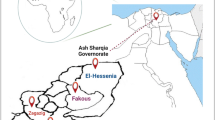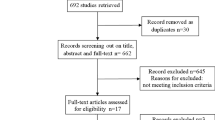Abstract
Enterocytozoon bieneusi and Blastocystis may cause diarrhea in humans and various animals. However, little information is available regarding the prevalence and genetic diversity of E. bieneusi and Blastocystis in donkeys. To fill this gap, we molecularly assessed E. bieneusi and Blastocystis in fecal samples from donkeys (n = 815) in Shanxi Province, north China. The overall prevalence of E. bieneusi and Blastocystis in donkeys was 8.1% and 0.2%, respectively. Region and age were risk factors associated with E. bieneusi infection in donkeys. Three internal transcribed spacer (ITS) genotypes of E. bieneusi were identified in the current study, including two previously described genotypes (D and Henan-IV) and one novel genotype (named SXD1). Of which, genotype D was found to be the most prevalent. Phylogenetic analysis demonstrated that the three genotypes belonged to group 1, implying a potential of zoonotic transmission. Multilocus sequence typing showed that 19, 15, 13, and 22 types were identified at the loci MS1, MS3, MS4, and MS7, respectively, forming six multilocus genotypes (MLGs) distributed in the genotype D. One Blastocystis subtype (ST33) was identified, which has previously been reported only in horses. This is the first molecular-based description of E. bieneusi and Blastocystis infections in donkeys in Shanxi Province, north China, contributing to a better understanding of transmission dynamics and molecular epidemiological characteristics of the two intestinal protozoa.

Similar content being viewed by others
Data availability
The authors declare that data supporting the findings of this study are available within the article. The representative sequences obtained in this study have been deposited in GenBank under the accession numbers: OR804086-OR804088 (E. bieneusi ITS sequences), OR813053-OR813080 (E. bieneusi MS1, MS3, MS4, and MS7 nucleotide sequences), and OR866211-OR866212 (Blastocystis SSU rRNA gene sequences).
References
Baek S, Maloney JG, Molokin A, George NS, Cortés Vecino JA, Santin M (2022) Diversity of Blastocystis subtypes in horses in Colombia and identification of two new subtypes. Microorganisms 10:1693. https://doi.org/10.3390/microorganisms10091693
Barati M, KarimiPourSaryazdi A, Rahmanian V, Bahadory S, Abdoli A, Rezanezhad H, Solhjoo K, Taghipour A (2022) Global prevalence and subtype distribution of Blastocystis sp. in rodents, birds, and water supplies: a systematic review and meta-analysis. Prev Vet Med 208:105770. https://doi.org/10.1016/j.prevetmed.2022.105770
Boorom KF, Smith H, Nimri L, Viscogliosi E, Spanakos G, Parkar U, Li LH, Zhou XN, Ok UZ, Leelayoova S, Jones MS (2008) Oh my aching gut: irritable bowel syndrome, Blastocystis, and asymptomatic infection. Parasit Vectors 1:40. https://doi.org/10.1186/1756-3305-1-40
Desportes I, Le Charpentier Y, Galian A, Bernard F, Cochand-Priollet B, Lavergne A, Ravisse P, Modigliani R (1985) Occurrence of a new microsporidan: Enterocytozoon bieneusi n.g., n. sp., in the enterocytes of a human patient with AIDS. J Protozool 32(2):250–254. https://doi.org/10.1111/j.1550-7408.1985.tb03046.x
Feng Y, Li N, Dearen T, Lobo ML, Matos O, Cama V, Xiao L (2011) Development of a multilocus sequence typing tool for high-resolution genotyping of Enterocytozoon bieneusi. Appl Environ Microbiol 77:4822–4828. https://doi.org/10.1128/AEM.02803-10
Han B, Pan G, Weiss LM (2021) Microsporidiosis in humans. Clin Microbiol Rev 34:e0001020. https://doi.org/10.1128/CMR.00010-20
Jian Y, Zhang X, Wang G, Wang G, Li X, Ma L, Liang Q, Li C, Zhang Y (2023) First report on the molecular detection of Enterocytozoon bieneusi in livestock and wildlife around Qinghai Lake in the Qinghai-Tibetan Plateau area, China. Int J Parasitol Parasites Wildl 21:110–115. https://doi.org/10.1016/j.ijppaw.2023.04.012
Kumarasamy V, Anbazhagan D, Subramaniyan V, Vellasamy S (2018) Blastocystis sp., parasite associated with gastrointestinal disorders: an overview of its pathogenesis, immune modulation and therapeutic strategies. Curr Pharm Des 24:3172–3175. https://doi.org/10.2174/1381612824666180807101536
Laatamna AE, Wagnerová P, Sak B, Květoňová D, Xiao L, Rost M, McEvoy J, Saadi AR, Aissi M, Kváč M (2015) Microsporidia and Cryptosporidium in horses and donkeys in Algeria: detection of a novel Cryptosporidium hominis subtype family (Ik) in a horse. Vet Parasitol 208:135–142. https://doi.org/10.1016/j.vetpar.2015.01.007
Li W, Xiao L (2020) Ecological and public health significance of Enterocytozoon bieneusi. One Health 12:100209. https://doi.org/10.1016/j.onehlt.2020.100209
Li DF, Zhang Y, Jiang YX, Xing JM, Tao DY, Zhao AY, Cui ZH, Jing B, Qi M, Zhang LX (2019a) Genotyping and zoonotic potential of Enterocytozoon bieneusi in pigs in Xinjiang, China. Front Microbiol 10:2401. https://doi.org/10.3389/fmicb.2019.02401
Li W, Feng Y, Santin M (2019b) Host specificity of Enterocytozoon bieneusi and public health implications. Trends Parasitol 35:436–451. https://doi.org/10.1016/j.pt.2019.04.004
Li F, Wang R, Guo Y, Li N, Feng Y, Xiao L (2020a) Zoonotic potential of Enterocytozoon bieneusi and Giardia duodenalis in horses and donkeys in northern China. Parasitol Res 19:1101–1108. https://doi.org/10.1007/s00436-020-06612-8
Li W, Feng Y, Xiao L (2020b) Diagnosis and molecular typing of Enterocytozoon bieneusi: the significant role of domestic animals in transmission of human microsporidiosis. Res Vet Sci 133:251–261. https://doi.org/10.1016/j.rvsc.2020.09.030
Li W, Feng Y, Xiao L (2022) Enterocytozoon bieneusi. Trends Parasitol 38:95–96. https://doi.org/10.1016/j.pt.2021.08.003
Liang Y, Liu YY, Mei JJ, Zheng WB, Liu Q, Gao WW, Zhu XQ, Xie SC (2023) Molecular identification and genotyping of Cryptosporidium spp. and Blastocystis sp. in cattle in representative areas of Shanxi Province, north China. Animals (Basel) 13:2929. https://doi.org/10.3390/ani13182929
Ma YT, Zou Y, Liu Q, Xie SC, Li RL, Zhu XQ, Gao WW (2019) Prevalence and multilocus genotypes of Enterocytozoon bieneusi in alpacas (Vicugna pacos) in Shanxi Province, northern China. Parasitol Res 118:3371–3375. https://doi.org/10.1007/s00436-019-06503-7
Matos O, Lobo ML, Xiao L (2012) Epidemiology of Enterocytozoon bieneusi infection in humans. J Parasitol Res 2012:981424. https://doi.org/10.1155/2012/981424
Popruk S, Adao DEV, Rivera WL (2021) Epidemiology and subtype distribution of Blastocystis in humans: a review. Infect Genet Evol 95:105085. https://doi.org/10.1016/j.meegid.2021.105085
Qi M, Li J, Zhao A, Cui Z, Wei Z, Jing B, Zhang L (2018) Host specificity of Enterocytozoon bieneusi genotypes in Bactrian camels (Camelus bactrianus) in China. Parasit Vectors 11:219. https://doi.org/10.1186/s13071-018-2793-9
Rajamanikam A, Isa MNM, Samudi C, Devaraj S, Govind SK (2023) Gut bacteria influence Blastocystis sp. phenotypes and may trigger pathogenicity. PLoS Negl Trop Dis 7:e0011170. https://doi.org/10.1371/journal.pntd.0011170
Rudzińska M, Sikorska K (2023) Epidemiology of Blastocystis infection: a review of data from Poland in relation to other reports. Pathogens 12:1050. https://doi.org/10.3390/pathogens12081050
Santín M, Fayer R (2011) Microsporidiosis: Enterocytozoon bieneusi in domesticated and wild animals. Res Vet Sci 90:363–371. https://doi.org/10.1016/j.rvsc.2010.07.014
Stensvold CR, Clark CG (2016) Current status of Blastocystis: a personal view. Parasitol Int 65:763–771. https://doi.org/10.1016/j.parint.2016.05.015
Stensvold CR, Tan KSW, Clark CG (2020) Blastocystis. Trends Parasitol 36:315–316. https://doi.org/10.1016/j.pt.2019.12.008
Taghipour A, Bahadory S, Khazaei S, Zaki L, Ghaderinezhad S, Sherafati J, Abdoli A (2022) Global molecular epidemiology of microsporidia in pigs and wild boars with emphasis on Enterocytozoon bieneusi: a systematic review and meta-analysis. Vet Med Sci 8:1126–1136. https://doi.org/10.1002/vms3.751
Wang SS, Wang RJ, Fan XC, Liu TL, Zhang LX, Zhao GH (2018) Prevalence and genotypes of Enterocytozoon bieneusi in China. Acta Trop 183:142–152. https://doi.org/10.1016/j.actatropica.2018.04.017
Wang HY, Qi M, Sun MF, Li DF, Wang RJ, Zhang SM, Zhao JF, Li JQ, Cui ZH, Chen YC, Jian FC, Xiang RP, Ning CS, Zhang LX (2019) Prevalence and population genetics analysis of Enterocytozoon bieneusi in dairy cattle in China. Front Microbiol 10:1399. https://doi.org/10.3389/fmicb.2019.01399
Wei CN, Qin RL, Zhang ZH, Zheng WB, Liu Q, Gao WW, Zhu XQ, Xie SC (2023) Prevalence and genetic characterization of Blastocystis in sheep and pigs in Shanxi Province, north China: from a public health perspective. Animals (basel) 13:2843. https://doi.org/10.3390/ani13182843
Yue DM, Ma JG, Li FC, Hou JL, Zheng WB, Zhao Q, Zhang XX, Zhu XQ (2017) Occurrence of Enterocytozoon bieneusi in donkeys (Equus asinus) in China: a public health concern. Front Microbiol 8:565. https://doi.org/10.3389/fmicb.2017.00565
Zhao A, Zhang Y, Wang W, Jing B, Xing J, Tao D, Zhao W, Qi M (2020) Enterocytozoon bieneusi in donkeys from Xinjiang, China: prevalence, molecular characterization and the assessment of zoonotic risk. BMC Vet Res 16:196. https://doi.org/10.1186/s12917-020-02409-0
Funding
This work was supported by the Shanxi Province Excellent Doctoral Work Award—Scientific Research Project (Grant No. SXBYKY2021019), the Research Fund of Shanxi Province for Introduced High-level Leading Talents (Grant No. RFSXIHLT202101), the Fund for Shanxi “1331 Project” (Grant No. 20211331–13), and the Special Research Fund of Shanxi Agricultural University for High-level Talents (Grant No. 2021XG001).
Author information
Authors and Affiliations
Contributions
W-WG, QL, and X-QZ conceived and designed the experiments. SZ, T-HZ, and TJ performed the experiments, analyzed the data, and wrote the paper. NS, S-CX, SL, and XT participated in the implementation of the study. W-WG, QL, and X-QZ critically revised the manuscript. All authors have read and approved the final version of the manuscript.
Corresponding authors
Ethics declarations
Ethical approval
Ethical review and approval were not required for the animal study because this is not applicable. Written informed consent was obtained from the owners for the participation of their animals in this study.
Consent to participate
Not applicable.
Consent for publication
Not applicable.
Competing interests
The authors declare no competing interests.
Additional information
Handling Editor: Julia Walochnik
Publisher's Note
Springer Nature remains neutral with regard to jurisdictional claims in published maps and institutional affiliations.
Rights and permissions
Springer Nature or its licensor (e.g. a society or other partner) holds exclusive rights to this article under a publishing agreement with the author(s) or other rightsholder(s); author self-archiving of the accepted manuscript version of this article is solely governed by the terms of such publishing agreement and applicable law.
About this article
Cite this article
Zhang, S., Zhang, TH., Jia, T. et al. Prevalence and genotype/subtype distribution of Enterocytozoon bieneusi and Blastocystis in donkeys in Shanxi Province, north China. Parasitol Res 123, 108 (2024). https://doi.org/10.1007/s00436-024-08128-x
Received:
Accepted:
Published:
DOI: https://doi.org/10.1007/s00436-024-08128-x




